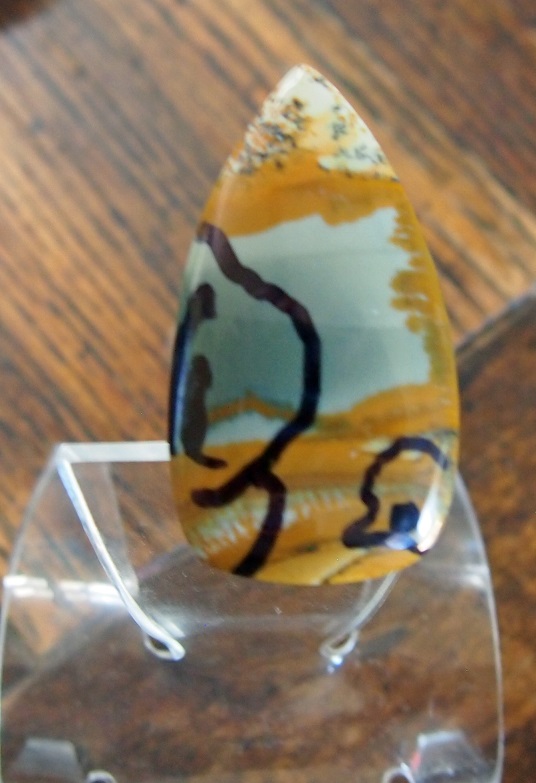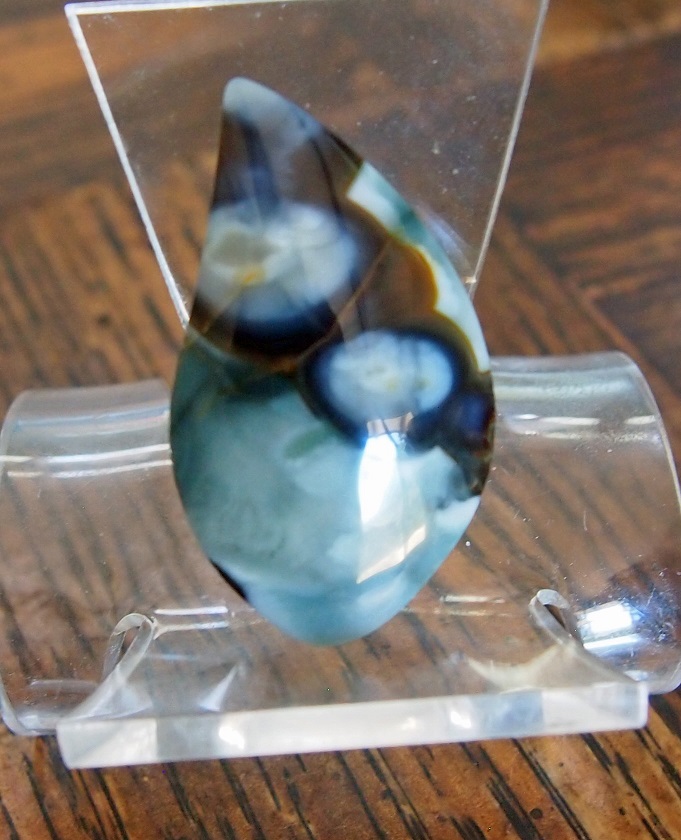|
|
Post by stardiamond on May 11, 2019 16:48:37 GMT -5
I pulled out cabs that I liked to list. I inspected them carefully because when they were made for me not to sell. I found the cab pictured and saw that there were scratches in the middle which was a little flat. I then noticed the dome was not centered. I made a much better dome starting at 80 grit and went through the steps through final polish. I did intermediate inspections. I did a final inspection and saw polished scratches. I went back to 325 through final polish with intermediate inspections. More scratches in the same kind of area. I don't mind twice but I need to got back to 325 (but not today). My eyes are not good dealing with reflective surfaces and the shape is not one I do a lot, The good news that the cab is getting better and the bad news is that my technique is flawed enough it is going to take 3 or more attempts to get it right.  |
|
|
|
Post by Pat on May 11, 2019 16:53:57 GMT -5
Nevertheless , it is a good looking cab!!
|
|
|
|
Post by rockjunquie on May 11, 2019 16:55:44 GMT -5
Worth the effort.  |
|
|
|
Post by stardiamond on May 11, 2019 17:22:08 GMT -5
Definitely. Finding good material isn't easy and I would rather spend my time fixing a nice cab than cut a new not as nice cab. I'm splitting my cabbing time time fixing and cutting new. I fixed this Tahoma today. It had some small cuts and improved the girdle. Only one attempt on this one.  |
|
|
|
Post by hummingbirdstones on May 11, 2019 17:39:27 GMT -5
I know it sucks to have to redo something, let alone multiple times. Are you using magnification of some sort to inspect your work?
One thing that I do that helps, because my eyesight is very crappy, is to hold the dry cab by my light and then look at the surface at a slight angle. Look past the actual cab (and the colors) and focus on the reflection the light is making on the cab. You will be able to see the scratches easier. I learned this technique when I started cutting opals, because it's very hard to see scratches in opal if you're looking at the stone and all the colors. Hope it helps!
|
|
|
|
Post by stardiamond on May 11, 2019 17:51:54 GMT -5
I wear 4x non prescription readers. Bought a loupe and it doesn't help. I have a magnifying glass on a stand that I may try and I have something called a bug inspector that might also help.
|
|
julieooly
Cave Dweller 
Member since October 2018
Posts: 721 
|
Post by julieooly on May 11, 2019 17:53:27 GMT -5
I like the second cab. I found I needed to let the cabs dry out completely and I got some 6+ readers from Amazon, putting it under a warm light bulb does the trick. Not much gets by me now, although the "do over" stack is getting taller. Running out of dop sticks  |
|
julieooly
Cave Dweller 
Member since October 2018
Posts: 721 
|
Post by julieooly on May 11, 2019 17:54:47 GMT -5
We were posting at the same time. If you wear a 4x already the 6 may not be strong enough. What also works is let it dry out then use your phone, take a pic and use the zoom to look at the cab.
|
|
|
|
Post by stardiamond on May 11, 2019 18:09:47 GMT -5
I'm a dinosaur and don't own a smart phone. I have a pay as you cell phone and don't go anywhere. I have an Olympus PM1 and photoshop. I have a cab that I put on etsy that had small pin prick pits. I took a couple pictures of the pitted area. Even though the pictures were in focus the pits didn't show. They were disclosed in the description so the picture at least showed they were hard to see. I'll try additional magnification before 600 and after 1200.
|
|
|
|
Post by Pat on May 11, 2019 18:17:42 GMT -5
I wear an optivisor over my regular prescription glasses. Examine cab when dry. Easier to detect scratches etc. hate to undo and redo. Good luck!
|
|
|
|
Post by MsAli on May 11, 2019 18:29:02 GMT -5
I put a magnifying app on my phone that has helped alot
Actually wearing my glasses might help too but bifocals drive me nuts
|
|
|
|
Post by stardiamond on May 11, 2019 18:34:36 GMT -5
I wear an optivisor over my regular prescription glasses. Examine cab when dry. Easier to detect scratches etc. hate to undo and redo. Good luck! I bought an optivisor a while ago and didn't like it for cabbing. I can try if for inspection. I cab standing up and coming inside to sit down and inspect works for me. If I could only see scratches before polishing |
|
|
|
Post by parfive on May 12, 2019 0:04:36 GMT -5
I'll try additional magnification before 600 and after 1200. If I could only see scratches before polishing TOO LATE. Don’t leave the 280 wheel until the cab is FLAWLESS. Every wheel after that is duck soup. And learn how to use the loupe. Hummingbird described exactly how to use it. ps – Film is cheap nowadays. Why do you post so many out-of-focus pics? |
|
|
|
Post by fernwood on May 12, 2019 6:24:51 GMT -5
I am constantly taking photos of what I am doing. Then open them on computer and enlarge/magnify. Only way I can see any flaws.
|
|
|
|
Post by Rockindad on May 12, 2019 6:55:00 GMT -5
I know it sucks to have to redo something, let alone multiple times. Are you using magnification of some sort to inspect your work?
One thing that I do that helps, because my eyesight is very crappy, is to hold the dry cab by my light and then look at the surface at a slight angle. Look past the actual cab (and the colors) and focus on the reflection the light is making on the cab. You will be able to see the scratches easier. I learned this technique when I started cutting opals, because it's very hard to see scratches in opal if you're looking at the stone and all the colors. Hope it helps!
Didn't use the loupe for a long time because I was trying to use it straight on all of the time, like a microscope. Using it as you describe, I stumbled into this by chance, makes a world of difference. Al |
|
|
|
Post by rockjunquie on May 12, 2019 8:13:03 GMT -5
I know it sucks to have to redo something, let alone multiple times. Are you using magnification of some sort to inspect your work? One thing that I do that helps, because my eyesight is very crappy, is to hold the dry cab by my light and then look at the surface at a slight angle. Look past the actual cab (and the colors) and focus on the reflection the light is making on the cab. You will be able to see the scratches easier. I learned this technique when I started cutting opals, because it's very hard to see scratches in opal if you're looking at the stone and all the colors. Hope it helps!
Didn't use the loupe for a long time because I was trying to use it straight on all of the time, like a microscope. Using it as you describe, I stumbled into this by chance, makes a world of difference. Al I wear readers and an optivisor. I wear a towel bib and wipe the stone a lot. It's very true about pictures. I can have a stone that I could swear by all that is holy is perfect, but as soon as I see the picture, I'm like WTH? I usually catch a micro fracture or pit that I never saw. It's like parfive says, check and double check during and after the 280 or 220 soft. That's where you will will find your scratches. After that's good, you're golden. Honestly, I don't even check half the time after the 280/220 (I have a 220 Nova). I rarely, if ever, find any scratches in the end result. eta - sorry Rockindad- didn't mean to quote you. Not arguing. |
|
|
|
Post by hummingbirdstones on May 12, 2019 9:39:49 GMT -5
I wear an optivisor over my regular prescription glasses. Examine cab when dry. Easier to detect scratches etc. hate to undo and redo. Good luck! I bought an optivisor a while ago and didn't like it for cabbing. I can try if for inspection. I cab standing up and coming inside to sit down and inspect works for me. If I could only see scratches before polishing I always wear my Optivisor while I'm working on a cab. I don't always have the lens' down. I flip it up and down when i need it to inspect the stone.
P.S. You can get different lenses in stronger magnifications (up to 7, I think) if you need them. They are very easy to change out.
|
|
|
|
Post by stardiamond on May 12, 2019 10:48:29 GMT -5
I'll try additional magnification before 600 and after 1200. If I could only see scratches before polishing TOO LATE. Don’t leave the 280 wheel until the cab is FLAWLESS. Every wheel after that is duck soup. And learn how to use the loupe. Hummingbird described exactly how to use it. ps – Film is cheap nowadays. Why do you post so many out-of-focus pics? I completely agree about the 280. Everything after is quick and automatic. The reason I posted this is vision problems. When the cab is polished all the defects stand out unpolished hard for me to see. I dry and look at under light and still miss a lot. I need to add more magnification to inspection. My hands sometimes move when pressing the shutter button and when the picture is good enough to show the issue I don't rephotograph. |
|
|
|
Post by Rockindad on May 12, 2019 13:58:05 GMT -5
Didn't use the loupe for a long time because I was trying to use it straight on all of the time, like a microscope. Using it as you describe, I stumbled into this by chance, makes a world of difference. Al I wear readers and an optivisor. I wear a towel bib and wipe the stone a lot. It's very true about pictures. I can have a stone that I could swear by all that is holy is perfect, but as soon as I see the picture, I'm like WTH? I usually catch a micro fracture or pit that I never saw. It's like parfive says, check and double check during and after the 280 or 220 soft. That's where you will will find your scratches. After that's good, you're golden. Honestly, I don't even check half the time after the 280/220 (I have a 220 Nova). I rarely, if ever, find any scratches in the end result. eta - sorry Rockindad - didn't mean to quote you. Not arguing. No problem, I was talking more in general terms, about using the loupe, as it was for checking tumbles. Al |
|